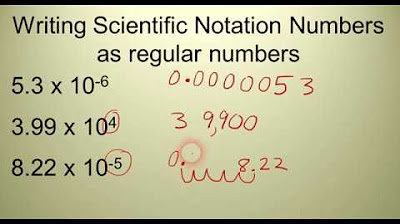Notação Científica
Summary
TLDRThis video explains scientific notation, a method used to simplify large or small numbers by expressing them as products of powers of 10. The presenter demonstrates how to convert numbers into scientific notation by shifting the decimal point and adjusting the exponent. Multiple examples are provided, showing conversions for both large and small numbers. The video also covers how to convert numbers from scientific notation back into their standard form by considering the positive or negative exponent. The goal is to help viewers understand and apply scientific notation in practical situations.
Takeaways
- 😀 Scientific notation is used to simplify large and small numbers using powers of 10.
- 😀 The general format of scientific notation is a number between 1 and 10 multiplied by a power of 10.
- 😀 To convert a large number into scientific notation, move the decimal point left until the number is between 1 and 10.
- 😀 When the decimal point is moved to the left, the exponent of 10 is positive.
- 😀 Example: 7,500,000,000 becomes 7.5 × 10⁹ in scientific notation.
- 😀 For small numbers, the decimal point is moved to the right to create a number between 1 and 10.
- 😀 When the decimal point moves to the right, the exponent of 10 is negative.
- 😀 Example: 0.000015 becomes 2 × 10⁻⁵ in scientific notation.
- 😀 Converting from scientific notation to a regular number involves moving the decimal point as many places as the exponent indicates.
- 😀 Example: 1.06 × 10⁸ becomes 106,000,000 when converted back to regular number form.
- 😀 Example: 8.23 × 10⁻⁵ becomes 0.0000823 when converted back to regular number form.
Q & A
What is scientific notation and why is it useful?
-Scientific notation is a way of writing very large or very small numbers in a simplified format, using powers of 10. It is useful for expressing numbers between 1 and 10, which helps to handle large or small numbers more easily.
How do you convert a large number like 7,500,000,000 into scientific notation?
-To convert 7,500,000,000 into scientific notation, move the decimal point 9 places to the left, resulting in 7.5. The scientific notation is 7.5 × 10^9.
What does the exponent represent in scientific notation?
-The exponent in scientific notation represents how many places the decimal point has been moved. A positive exponent means the decimal point moved to the left, while a negative exponent means it moved to the right.
How do you determine the exponent when converting a number to scientific notation?
-The exponent is determined by counting how many places the decimal point needs to move to get a number between 1 and 10. If you move the decimal point to the left, the exponent is positive. If you move it to the right, the exponent is negative.
Can you give an example of converting a small number like 0.00000814 into scientific notation?
-To convert 0.00000814 into scientific notation, move the decimal point 5 places to the right to get 8.14. The scientific notation is 8.14 × 10^-6.
What happens when you have a negative exponent in scientific notation?
-A negative exponent in scientific notation indicates that the original number is very small. When converting it to standard form, you move the decimal point to the left.
How do you convert scientific notation back to a standard number?
-To convert from scientific notation to a standard number, you move the decimal point based on the exponent. For positive exponents, move the decimal point to the right, and for negative exponents, move it to the left.
How do you convert a number like 2,000 into scientific notation?
-To convert 2,000 into scientific notation, move the decimal point 3 places to the left to get 2. The scientific notation is 2 × 10^3.
What is the process for converting a number with a positive exponent, like 1.06 × 10^8, back to standard form?
-For a positive exponent like 1.06 × 10^8, you move the decimal point 8 places to the right to get the standard form, which is 106,000,000.
What happens if the exponent is negative, like in 8.23 × 10^-5?
-If the exponent is negative, like in 8.23 × 10^-5, you move the decimal point 5 places to the left. The standard form of this number is 0.0000823.
Outlines

This section is available to paid users only. Please upgrade to access this part.
Upgrade NowMindmap

This section is available to paid users only. Please upgrade to access this part.
Upgrade NowKeywords

This section is available to paid users only. Please upgrade to access this part.
Upgrade NowHighlights

This section is available to paid users only. Please upgrade to access this part.
Upgrade NowTranscripts

This section is available to paid users only. Please upgrade to access this part.
Upgrade NowBrowse More Related Video

Scientific Notation

Perpangkatan dan Bentuk Akar [Part 8] - Notasi Ilmiah

Scientific Notation: Introduction

How to Use Scientific Notation and Unit Conversions | Physics in Motion

Menuliskan Bilangan ke Dalam Bentuk Notasi Ilmiah yang Baku | Matematika SMP

NOTAÇÃO CIENTÍFICA | POTÊNCIAS DE BASE 10 | \Prof. Gis/
5.0 / 5 (0 votes)